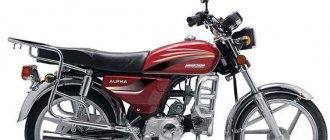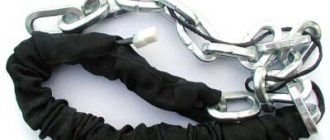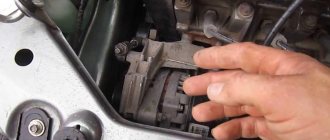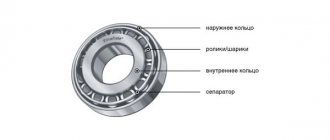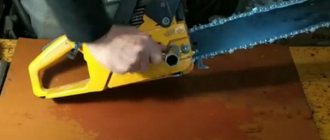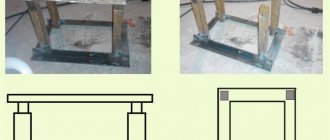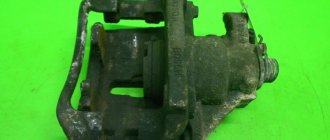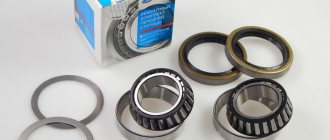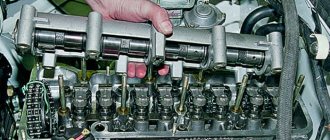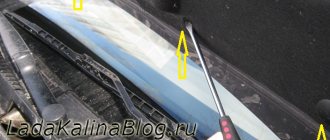A typical text from a seller of a car with a timing chain drive looks like this: “This is a chain, not a belt. This means there is no need to spend time and money on replacing the timing belt.” Many buyers fall for this trick. Ultimately, the chain ends up broken and the engine requires major overhaul. Remember: the era of chains capable of serving more than a million kilometers ended long ago along with the old Mercedes!
A broken timing belt is a serious incident, but in most cases there is hope of saving the engine. A similar situation with the timing chain can end much worse. The chain is much more massive than the belt and in the event of a break, as a rule, it “tears and tosses” the engine, “carrying with it” whole pieces of metal. In addition, pistons and valves are severely damaged. Very rarely, after a broken timing chain, the engine can be revived with little bloodshed.
The timing chain is no longer immortal!
A typical text from a seller of a car with a timing chain drive looks like this: “This is a chain, not a belt.
This means there is no need to spend time and money on replacing the timing belt.” Many buyers fall for this trick. Ultimately, the chain ends up broken and the engine requires major overhaul. Remember: the era of chains capable of serving more than a million kilometers ended long ago along with the old Mercedes! A broken timing belt is a serious incident, but in most cases there is hope of saving the engine.
A similar situation with the timing chain can end much worse. The chain is much more massive than the belt and in the event of a break, as a rule, it “tears and tosses” the engine, “carrying with it” whole pieces of metal. In addition, pistons and valves are severely damaged. Very rarely, after a broken timing chain, the engine can be revived with little bloodshed.
Installing the chain by marks
If repair work has been carried out on the timing drive or the chain is highly stretched, such that the marks on the camshaft gear and crankshaft pulley do not match the corresponding marks on the bearing housing and engine block, an adjustment must be made and the chain installed correctly.
Tools you will need:
- Screwdriver Set;
- key for rotating the crankshaft;
- a set of keys.
To install the chain, follow these steps:
- Remove the cover, filter and its housing.
- We disconnect the crankcase exhaust pipe from the carburetor, and also loosen the fasteners of the choke cable to remove the cable.
Video: setting valve timing on a VAZ 2101–07
It's all about the oil
The approximate resource of a modern chain is at least 200-250 thousand km. However, it often does not last that long. There are widely known cases of chain breaks after a mileage of 100,000 km, and even 60,000 km. The fact that this only occurs with certain car models suggests a birth defect. Moreover, a “disaster” does not always occur due to poor-quality manufacturing of the chain and tensioner. Sometimes the problem is caused by a lack of lubrication. This happened with the first Peugeot-Citroen 1.6 THP gasoline engines (Euro 4) and the BMW 2-liter diesel engine (BMW 3 E90, 320d N47).
Thus, failure to comply with the manufacturer’s recommendations regarding the amount, type of oil and replacement intervals greatly increases the likelihood of a malfunction. Do not forget that almost every chain is held in tension by a tensioner, the effectiveness of which directly depends on the pressure in the lubrication system. A typical example is the Fiat 1.3 Multijet turbodiesel, which is used in Opel models with 1.3 CDTI. With frequent movements in urban environments, the oil level drops significantly. If this is not noticed in time, then the pressure in the system begins to decrease, and, consequently, the chain tension.
But, of course, it cannot be done without errors in the design of the design of the chains and tensioners themselves. A striking example is the VW 1.4 TSI and 1.2 TSI gasoline engines.
Practical advice
When buying a used car with a timing chain drive, you should have a mechanic check the condition of the chain. Unlike engines with a belt, you should not be guided by the “just in case” rule of replacement. If the inspection shows the need to replace the chain, you will have to prepare from 500 to several thousand dollars. This is a serious reason to bargain with the car seller on the secondary market. In any case, there is no need to delay the replacement.
When operating a vehicle with a timing chain drive, you should be pedantic in matters relating to engine oil. Only high-quality oil must be used. Regular replacement is another important element of caring not only for the engine, but also for the timing chain drive. As a rule, lubricant changes should occur at least once every 15,000 km. If the car is operated mainly in urban driving conditions (frequent starts, a large proportion of idling time), then it is better to reduce the replacement interval to 10,000 km.
It is necessary to pay attention to unusual sounds (noise, knocking), especially those that appear immediately after starting or during prolonged idling. Having discovered characteristic signs of “disease”, it is worth visiting a car service center. Perhaps these are the first symptoms of a malfunctioning timing drive that cannot be ignored.
Consequences of malfunctions
Problems in the timing chain drive lead to the following problems:
Note. Chain drives of the timing unit can be single- or double-row. The former are not as reliable and durable as the latter, and often break down after a run of 50-80 thousand km. Double-row drives break extremely rarely, even when the owner of the car does not pay due attention to it.
Double-row chains also break, but very rarely.
The consequences of the listed problems can be as follows:
This is what the valves look like after meeting the pistons
A chain that has jumped or broken while driving makes itself felt by a sharp loss of power or complete engine failure. If you were able to hear a metallic knock, indicating the meeting of the piston and valve, then you should prepare for serious repairs to the power unit.
And this is a piston pierced by a valve plate
Two ways to place the timing chain in the engine
In engine building, two types of timing drive locations are used. Let's call them front and back. “Front”, when the timing drive is located on the same side as the drive belt of the mounted units. “Rear”, when the timing drive is located on the flywheel and gearbox side. Typically, manufacturers use a front-mounted timing drive, since this arrangement makes it easier to access and repair the system. However, for several years now, companies such as Audi and BMW have been practicing the placement of the timing drive on the rear side of the engine: Audi A6 C6 3.0 TDI, BMW 320d E90 (N47), BMW 530 F10. This greatly complicates timing maintenance. Fortunately, such bold solutions are used only in some engines with a timing chain drive, and are never used in engines with a timing belt.
Reliable and unreliable timing chain drives
However, manufacturers still produce cars with a timing chain that can last the entire service life of the engine. As a rule, problems with such timing belts do not arise for several hundred thousand kilometers. However, this does not relieve the owner of the responsibility to regularly check the condition of the timing chain drive.
Cars with a long-lasting timing chain : Ford Mondeo 1.8 TDCi, Mercedes C 200 CDI W202, Mercedes W124, Toyota Yaris 1.4 D-4D.
Cars with a short-lived timing chain : Audi A8 3.0 TDI (D3), Mazda CX-7 2.3 Turbo, Skoda Fabia 1.2 TSI, BMW 118d (N47), Peugeot 207 1.6 THP, VW Golf V 1.4 TSI.
How to determine that the timing chain has stretched and change it yourself
The timing chain drive transmits rotational motion from the crankshaft to the camshaft. The toothed chain is characterized by reliability, smoothness and noiselessness during operation. High-quality chains do not stretch or compress during operation. On the other hand, these elements have their own maximum service life. Failure to replace it in a timely manner can lead to costly repairs.
A little theory
Chain drives transmit rotational force from the crankshaft to the camshaft, which is located in the cylinder head of overhead valve engines.
Chains are divided into 2 categories. They can be toothed or roller. Roller mechanisms, unlike gear ones, are not so widespread. Therefore, it is gear systems that are most often found on cars with a timing belt, which include a chain drive. Gear units are distinguished by their high smoothness, they are quite reliable, and produce an insignificant level of noise during the operation of the internal combustion engine. In terms of their characteristics, the use of toothed chains brings them much closer to belt drives. One can argue endlessly about which one is better. But we won’t dwell on this today.
The chain is tensioned due to the operation of hydraulic tensioners, for which motor oil is used as a working fluid. The lubricant is supplied through the engine lubrication system.
Depending on the number of camshafts, that is, camshafts, the number of tensioners also differs. On cars there are from 1 to 3 units.
The service life of the chain directly depends on what the element is made of, how high quality it is and the degree of effectiveness of the heat treatment performed. Similar requirements are placed on timing sprockets, since they constantly operate together with the chain. Do not forget about the influence on the condition of the unit of the engine lubrication system, the quality of the oil itself and timely replacement of the fluid. In practice, when the part is made of high-quality materials, and the correct tension was carried out as part of the service, plus lubricant was introduced on time, then replacing the chain may be necessary at the same time as replacing the motor itself.
That is, you understand that a stretched chain cannot function for a long time and effectively. If you want to extend the life of this unit, initially take a high-quality chain, adjust its tension correctly and lubricate the drive generously with high-quality oil.
What is the danger of a stretched chain and is there a replacement regulation?
The most common breakdowns are:
The service life of a timing chain is approximately 100,000 kilometers. Most car manufacturers claim that this element can work almost forever.
In reality, constant vibrations at high speeds during engine operation provoke excessive drive tension. This will inevitably lead to its destruction. Thus, it is important to monitor the condition of the chain drive and replace it in a timely manner. Such measures can prevent significant repair costs.
Differences between a chain and a belt
One of the main differences between a timing chain and a timing belt is that a timing chain can cause more damage if it breaks than a timing belt. When the timing chain breaks, it causes irreparable damage to the engine, which subsequently becomes virtually unusable.
Another difference between a timing chain and a belt is that the chain tensioners are controlled by engine oil pressure. Since good timing chain lubrication depends on the quality of the oil, it is important to change it periodically. If the level drops too much, the tensioners will lock and the timing chain will also be damaged.
The advantage of this timing system is that it does not interact with the water pump, and therefore we do not need to replace the water pump along with the timing chain.
In its function it resembles a timing belt, but is more durable. While some manufacturers claim that the timing chain can age along with the vehicle itself, others recommend frequent replacement.
Symptoms of wear
The failure of a circuit can be determined by the following signs:
If you ignore such signals, the valves may bend, and in the worst case scenario, the cylinder block will completely fail.
Therefore, during each scheduled inspection of the car, this timing element should be checked. When purchasing a used car, this element should be given sufficient attention.
DIY replacement algorithm
Today there are single-row and double-row timing chains. They differ in the number of links (114 and 116). Each of these varieties has its own advantages and disadvantages:
To replace a worn chain drive, you will need the following tools:
Before this procedure, you need to de-energize the battery by removing its terminals. Work to replace the chain drive should be carried out according to the following algorithm:
After dismantling, you can proceed to installing a new element:
After tightening the crankshaft bolts, it is necessary to check the location of the mark on the flywheel. If there is a coincidence, reassemble in the reverse order of removal.
Thus, the task of the timing chain is quite complex, so a beginner is unlikely to cope with it. If a motorist is not confident in his abilities, then it is better to seek professional help at a service station.
After this, not every owner can make the decision to replace the chain. Many people are puzzled why the chain stretched so early, because the mileage is not at all critical... The point is to convince a person that 90% of the mileages on the instruments do not correspond to reality and were twisted during the next sale (and possibly more than once) -it doesn’t always work out. This usually happens after a mileage of 170-200 thousand.
Of course, this is not at all like changing a timing belt - this is a completely different level of procedure that requires other investments, other skills and other time costs. Therefore, everyone wants to move the replacement procedure as far as possible from the real need for this (which has already occurred). They begin visiting services and trying to put out errors, to find a “Kulibin” who can correct the situation with a device (although it is clear to everyone that this is not possible). There was so much advice on the Internet about replacing sensors and turning them around, turning them in order to deceive the control unit and put out the check engine light. As an example, turn the camshaft sensor. Many have tried to rotate the camshaft sensor in order to catch the desired synchronization when stretching the chain. You can often find throwing the chain over one tooth of the camshaft sprocket, which made it possible to create an illusion, or rather deception, when selling a tired engine for a car. But the problem was not solved, We just tried to adapt to it. If during diagnostics there is a real suspicion of chain stretching, then the chain must be changed as standard, and only with a new, original one, and not with one that is cheaper and available (you will not like “plasticine” chains that will make themselves known after a couple of dozen thousand kilometers, or even earlier).
The second way to determine is to remove the front engine cover
The replacement procedure is quite complicated. The replacement procedure for the masters takes 4-5 hours. Replacing a chain is an expensive procedure, so an accurate diagnosis is needed. When ordering parts, you should take into account the circumstances of low production of gears and guides, so as not to waste money. Be sure to change the chain (original), tensioner and two long guides. After replacing the chain, owners always notice increased dynamics, reduced fuel consumption and reduced engine noise.
When the thought arises that “there is something wrong with the circuit,” everyone is waiting for some hint from the on-board computer about an error in this unit. Well, of course - if the chain is stretched, an error should appear... - logical, but this will not happen. However, the original manual for this error is also not entirely “intelligible”:
Error P0335 is interpreted as a malfunction of the crankshaft sensor and its electrical circuits. When NISSAN released QG engines with “plasticine chains” (pre-restyling versions were taken into account later), dealers acted according to the manual, but it said nothing about possible chain stretching. Therefore, with code P0335: - they changed the sensor (sometimes several times) - they changed the control unit and diagnostic equipment - they changed something else - but the car still had the same problem.
How to choose a new set of spare parts?
Like other KAMAZ automobile spare parts, timing chains are counterfeited by handicraft and Chinese manufacturers, after which they go on sale. Cunning businessmen are constantly coming up with new ways to deceive customers, for example, placing their low-quality products in original packaging from well-known brands originally from Western Europe. To avoid running into a fake spare part when purchasing a part, follow these recommendations:
The chain is checked for deflection as follows: take it by one end and hold it flat. The second end should sag no more than 10 mm. If possible, check the hardness of the metal by carefully filing it with a file. The steel in high-quality products is hardened, and therefore is characterized by increased hardness and does not lend itself to filing.
Chain, gears, shoes and tensioner - complete replacement kit
Advice. The main technical characteristics of the chain are its size and number of links, and you need to select the part based on them. If you are in doubt, then do not buy a new spare part without removing the old one with which you can compare it.
If you are updating a chain drive with a significant mileage of the car (150-200 thousand km), then you will have to change all the accompanying elements - gears, tensioner and damper. When the chain has stretched after a run of 50-100 thousand km, it is not necessary to change the gears, but the tensioner must be checked for functionality. Also, don't forget to buy consumables - cover gaskets, O-rings and heat-resistant sealant.
How to choose the right spare part
Chains are divided into several types according to the number of links. The choice depends on the make of the car and the characteristics of the engine used in it. Thus, in VAZ 2101 and 2102 and other cars with an engine displacement of 1.2 and 1.3 liters, models with 114 links are used. A 116-link chain will be useful to the owner of a car with an engine capacity of 1.5, 1.6 and 1.7 liters (this is VAZ 2103, 2107 and Niva). It is better to check the exact information about a suitable kit in the documentation for the vehicle.
Why does a motorcycle chain stretch?
The question of the reasons for chain stretching among motorcyclists arises constantly. But, despite numerous discussions on forums and written articles, the question remains. You can often see the following explanation: “Yes, this is Chinese raw meat.” How to explain the stretching of a famous brand chain? Chinese fake? What if we know for sure that the original chain has stretched?
The structure of the roller chain and its weak points
We have already talked about the design of the drive roller chain, so here we will only touch on general points. So, a roller chain consists of external and internal links. The internal link consists of internal plates and bushings pressed between them. The outer link consists of outer plates and press-fitted rollers. The mobility of the links is ensured by the movement of the roller inside the bushing. The roller is located on the bushing and rotates freely, ensuring sliding along the sprocket.
The service life of the drive chain depends precisely on the quality of the joints of the chain links:
As long as there is lubrication between the bushing and the roller, the link has normal, natural mobility. But if there is a fact of rotation of the sleeve in the inner plate or the roller in the outer one, then friction, heating and increased wear occur. Thus, these are the weak points. Moreover, it should be noted. The larger the contact area between the roller and the plate (the diameter of the roller and the width of the plate), the bushing and the plate (the diameter of the bushing and the width of the plate), the lower the risk of rotation.
As a result of turning, the metal gradually wears out and wears out. Increasing the diameter of the holes in the plates by 0.1 mm (0.05 mm radius) per 100 links will increase the chain length by 5 mm. What if the hole in the plates increased by 1 mm on all 100 links? At 50 mm? But this is more than 3 links of a 5xx chain. Naturally, this is rather a utopian situation, but it is a good indication of weaknesses in the drive chain.
These are the consequences that can result from lack of lubrication, poor riveting of the rollers and pressing of the bushings. Naturally, the quality of the metal also matters. It is for this reason that chain manufacturers carry out local hardening of the metal in the area of the plate hole, and for the tightest connection of the bead with the outer plate, four-sided riveting is used.
So, chain elongation occurs due to the gradual wear of chain elements. But this happens slowly.
Fragment of a comment on the forum
Motorcycle chain drive
The chain drive of a motorcycle is the most common drive method, but its use is associated with a number of difficulties. A motorcycle is not a stationary machine. Even other types of motor vehicles that use a chain drive have fewer difficulties.
The chain drives the rear wheel, which in most cases is mounted on a swingarm. The pendulum is moving. As a consequence, the chain tension changes depending on the position of the pendulum . The point of greatest chain tension varies among different motorcycle models. With different loads on the rear shock absorber, when driving over rough terrain, and so on, short-term moments of chain overtension may occur, as a result, wear becomes uneven.
All this leads to the fact that correct adjustment of chain tension, especially a new one, is the most important factor when stretching a motorcycle chain. A chain that is too tight will always cause uneven stretching due to uneven wear.
Motorcycle chain with uneven tension. Tense state
Motorcycle chain with uneven tension. Weakened state
Features of motorcycle operation
So, imagine a motorcycle stands still, has two points of contact, two wheels (we won’t take into account the legs). When a gear is engaged and released, the driving sprocket begins to move while the driven sprocket is at rest. The drive chain at the top experiences a sharp tension . There is a well-known saying: “Water wears away stones.” In this case, the outer plates pull the roller, and a groove gradually appears at the place where they meet - the length of the chain increases.
A similar situation occurs with a sharp increase in gas while driving. Accordingly, this also leads to increased wear. The more wear in the joints, the more damage each “starting” of the motorcycle and sharp acceleration will cause, which means that the rate of chain stretching will increase.
It turns out that the wear of the drive chain is affected by the driving style of the motorcycle, and the force of the chain jerk is also affected by the power of the motorcycle. If you prefer an aggressive driving style, sharp acceleration, rough terrain, then it is better to choose reinforced chain options.
Many chain manufacturers make tables for their range of chains corresponding to engine volume. This is a conditional guideline; you should not focus on the upper limit.
Timely adjustment of the motorcycle chain
We won’t talk about how to adjust chain tension. There are many articles about this. In general, it is better to rely on the instructions or, as they often say now, the manual for adjusting the chain in a specific model and brand. Since the points of greatest tension in a loaded and unloaded state may be different, and the manufacturer must notify about this in the instructions.
How to check the chain tension on a VAZ 2101-VAZ 2107?
1) At the beginning of the operation, you will need to remove that same cover, read about how it is removed in the article: “Setting the valve timing by marks”, in this article everything is explained and chewed in detail, and you need to study it starting from point 1 and ending with 10 , in these points the removal of the cover is explained.
2) Now that the cover is removed and it no longer bothers you, proceed to checking the chain tension, this check can be done either with a screwdriver or by hand, but it is better with a screwdriver, to do this, install it in two different ways, as shown in the two photographs below, and in these position, check the tension of the chain in the photo below, where you need to move the screwdriver is shown in detail, but we will still look at these photos a little, the first photo shows how to insert the screwdriver and use it as a lever to press on the chain (It shouldn’t bend if it bends just a little then adjust the chain using the tensioner), then go to the other side of the chain (see photo 2) and also install a screwdriver and use it to press the chain in that place (You can also try to push the chain with your finger), the chain should also not bend and the string should be tensioned, and this is how the chain tension on classic cars is determined.
Note! You need to press on the chain with medium force, but in no case should you press with all your strength, even though it is metal, this does not exclude its deformation!
Additional video clip: For more details about what tension the chain should have, see the video below, it shows the installation of the chain on the engine removed from the car and at the very end it explains and also shows what adjustment should be.
